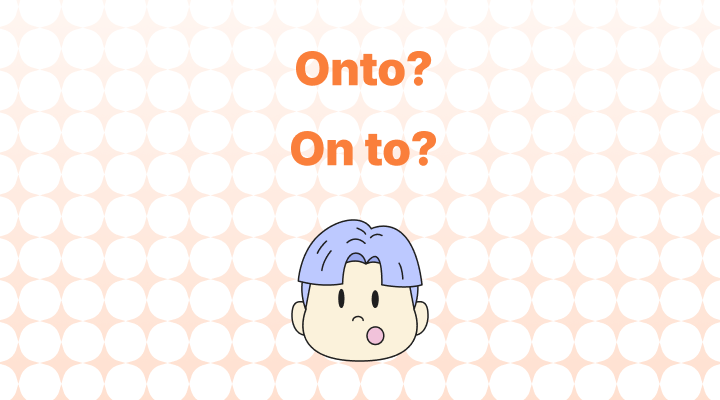Like the into vs. in to debate, the onto vs. on to dispute is a famous one.
Onto: on, to be situated or positioned on top of
Onto is a preposition that expresses the position of a certain object or person on top of another. You step onto a train platform. You roll onto your back. There will be more examples of onto being used in sentences later.

On to: two words, with on used as a part of a phrasal verb
Examples of phrasal verbs include.
Catch on: If you act suspicious, he will catch on to your act
Go on: Bob will go on to study law
Move on: Let’s move on to the next topic
Read on: Read on to find out what happens to the protagonist
How do you know which to use?
An easy way to distinguish whether you should be using onto or on to is as follows.
- If it is being used to describe the position of something on top of another, use onto.
- If on is part of a phrasal verb, use on to. The phrasal verb consists of on and the word directly preceding it.
Example sentences
Onto
Ryan climbed onto the cargo bed of the truck.
In this example, we use onto because the subject Ryan positioned himself on top of the cargo bed of the truck.
Drive onto the pavement, and then take a left at the intersection.
This sentence is directing the listener to drive on top of the pavement, so we use the positional onto instead of on to.
When Helen smelled smoke, she threw herself onto the ground.
Here, Helen is placing herself on the ground. Hence, we use the positional onto instead of on to.

On to
After trigonometry, we will move on to math analysis and calculus, so bring your calculus textbook to class.
In this example, the on in on to is part of the phrasal verb move on. Because on is a part of a phrasal verb, we use on to here, instead of the positional onto.
Caleb still held on to his dream, despite all the hardships and challenges that stood in his way.
Held on, the past tense of hold on, is another phrasal verb. We use on to instead of onto because the on is a part of the phrasal verb held on.
Please read on to learn more about the causes and symptoms of skin cancer, specifically non-genetic skin cancer.
Again, the on here is part of a phrasal verb, which in this case is read on. Because on is part of this phrasal verb, like the other two examples above, we use on to instead of onto in this sentence.
Practice questions
Here are some practice questions you can try to test if you know when to use onto and on to. Find the answers below.
- She skated onto/on to the fake ice which felt odd and disorienting.
- The child went onto/on to the ride without his parents.
- The cat jumped onto/on to the piano gracefully.
- Stephen Hawking went onto/on to writing several bestsellers and win multiple awards.
- The dog climbed onto/on to the new porch and skipped about happily.
- Jeff will go onto/on to become a doctor to help as many people as he can.
- The police quickly caught onto/on to the shoplifter and arrested him.
- He rolled onto/on to his stomach and continued reading for the rest of the night.
- Tim wanted to be the first person to step onto/on to the new stage.
- The professor gradually moved onto/on to research Homo habilis skeletons.
Answers to practice questions:
- onto
- onto
- onto
- on to
- onto
- on to
- on to
- onto
- onto
- on to
Start for Free













